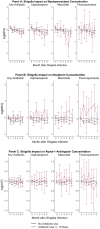Transitory impact of subclinical Shigella infections on biomarkers of environmental enteropathy in children under 2 years
- PMID: 40440324
- PMCID: PMC12143526
- DOI: 10.1371/journal.pntd.0012791
Transitory impact of subclinical Shigella infections on biomarkers of environmental enteropathy in children under 2 years
Abstract
Clinical and subclinical Shigella infections among children living in low- and middle-income countries (LMICs) have been associated with long-term adverse effects such as impaired linear growth. The mechanism for the impact of subclinical infections has been theorized to occur through contributions to environmental enteropathy (EE). While Shigella has previously been associated with biomarkers of EE at the time of infection, we evaluated whether this impact was sustained after infections, which would support EE being the mechanism for the effects of Shigella on growth. A prospective birth cohort study of 1,715 children living in 8 different LMICs was conducted. Over the course of 24 months, monthly non-diarrheal stool samples were analyzed for subclinical Shigella infections through quantitative PCR methods. EE was reflected by elevated concentrations of 3 fecal biomarkers: myeloperoxidase (MPO), neopterin (NEO), and alpha-1-antitrypsin (AAT). MPO concentrations were found to be significantly higher by 0.30 ln(nm/mL) (95% CI: 0.23, 0.37) in the initial month of Shigella detection among stools with subclinical Shigella infections. After the Shigella infection, MPO concentrations declined throughout the following 6 months, and concentrations were lower by 6 months post-infection [MPO 6-month difference: -0.16 ln(nm/mL) (95% CI: -0.26, -0.04)]. Subclinical Shigella infections had no effect on NEO concentration levels within the initial month of Shigella detection but did decrease post-infection. Subclinical Shigella infections had no effect on AAT concentration levels until 6 months post-infection [AAT difference: -0.13 ln(mg/g) (95% CI: -0.24, -0.03)]. These findings did not differ by antibiotic use around time of index infection. The impact of Shigella on biomarkers of EE was not sustained, suggesting the negative association between Shigella and growth could be explained by the accumulation of time-limited rather than persistent effects on inflammation.
Copyright: © 2025 Liakakos et al. This is an open access article distributed under the terms of the Creative Commons Attribution License, which permits unrestricted use, distribution, and reproduction in any medium, provided the original author and source are credited.
Conflict of interest statement
The authors have declared that no competing interests exist.
Figures


Similar articles
-
Fecal Markers of Environmental Enteropathy and Subsequent Growth in Bangladeshi Children.Am J Trop Med Hyg. 2016 Sep 7;95(3):694-701. doi: 10.4269/ajtmh.16-0098. Epub 2016 Jun 27. Am J Trop Med Hyg. 2016. PMID: 27352872 Free PMC article.
-
Environmental Enteropathy, Micronutrient Adequacy, and Length Velocity in Nepalese Children: the MAL-ED Birth Cohort Study.J Pediatr Gastroenterol Nutr. 2018 Aug;67(2):242-249. doi: 10.1097/MPG.0000000000001990. J Pediatr Gastroenterol Nutr. 2018. PMID: 29620600
-
Causal Pathways from Enteropathogens to Environmental Enteropathy: Findings from the MAL-ED Birth Cohort Study.EBioMedicine. 2017 Apr;18:109-117. doi: 10.1016/j.ebiom.2017.02.024. Epub 2017 Mar 8. EBioMedicine. 2017. PMID: 28396264 Free PMC article.
-
Dynamics and Trends in Fecal Biomarkers of Gut Function in Children from 1-24 Months in the MAL-ED Study.Am J Trop Med Hyg. 2017 Feb 8;96(2):465-472. doi: 10.4269/ajtmh.16-0496. Epub 2016 Dec 19. Am J Trop Med Hyg. 2017. PMID: 27994110 Free PMC article.
-
Microbiology and diagnosis of infections with Shigella and enteroinvasive Escherichia coli.Rev Infect Dis. 1991 Mar-Apr;13 Suppl 4:S220-5. doi: 10.1093/clinids/13.supplement_4.s220. Rev Infect Dis. 1991. PMID: 2047641 Review.
References
-
- GBD 2015 Mortality and Causes of Death Collaborators. Global, regional, and national life expectancy, all-cause mortality, and cause-specific mortality for 249 causes of death, 1980-2015: a systematic analysis for the global burden of disease study 2015. Lancet. 2016;388(10053):1459–544. doi: 10.1016/S0140-6736(16)31012-1 - DOI - PMC - PubMed
-
- Rogawski McQuade ET, Shaheen F, Kabir F, Rizvi A, Platts-Mills JA, Aziz F, et al.. Epidemiology of Shigella infections and diarrhea in the first two years of life using culture-independent diagnostics in 8 low-resource settings. PLoS Negl Trop Dis. 2020;14(8):e0008536. doi: 10.1371/journal.pntd.0008536 - DOI - PMC - PubMed
MeSH terms
Substances
Grants and funding
LinkOut - more resources
Full Text Sources
Research Materials
Miscellaneous

